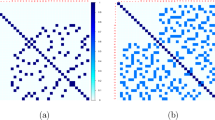Abstract
The models in structured families correspond to the treatments of a fixed effects base design \(\pi \). Then the action of factors in \(\pi \), on the fixed effects parameters of the models, is studied. Analyzing such a families enables the study of the action of nesting factors on the effects and interactions of nested factors. When \(\pi \) has an orthogonal structure, the family of models is said to be orthogonal. The models in the family can have one, two or more strata. Models with more than one stratum are obtained through nesting of one stratum models. A general treatment of the case in which the base design has orthogonal structure is presented and a special emphasis is given to the families of prime basis factorials models. These last models are, as it is well known, widely used in fertilization trials.
Similar content being viewed by others
References
Bailey RA (2008) Design of comparative experiments. Cambridge University Press, Cambridge
Carvalho F, Mexia JT, Covas R (2010). Structured families of models with commutative orthogonal block structures. AIP Conf Proc 1281:1256–1259. doi:10.1063/1.3497922
Cheng C-S, Martin RJ, Tang B (1998) Two-level factorial designs with extreme numbers of level changes. Ann Stat 26:1522–1539
Cheng S-W, Wu CFJ (2002) Choice of optimal blocking schemes in two-level and three-level designs. Technometrics 44:269–277
Fonseca M, Mexia JT, Zmyslony R (2006) Binary operations on Jordan algebras and orthogonal normal models. Linear Algebra Appl 417:75–86
Fonseca M, Mexia JT, Zmyslony R (2007) Jordan algebras, generating pivot variables and othogonal normal models. J Interdiscip Math 10(2):305–326
Fontana R, Pistone G, Rogantin MP (2000). Classification of two-level factorial fractions. J Stat Plan Inference 87:149–172.
Hoke AT (1974) Economical second-order designs based on irregular fractions of the $3^n$ factorial. Technometrics 16:375–384
Jesus V, Mexia JT, Fonseca M, Zmyślony R (2009) Binary operations and canonical forms for factorial and related models. Linear Algebra Appl 430:2781–2797
Mexia JT (1990) Best linear unbiased estimates, duality of F tests and Sheff multiple comparison method in presence of controlled heteroscedasticity. Comput Stat Data Anal 10(3):271–281
Montegomery D (2005) Design and analysis of experiments, 6th edn. Willey, New York
Moreira E, Mexia J (2011) Multi-treatment regression analysis: the unbalanced case. In: WSEAS proceedings of the 5th international conference on applied mathematics, simulation, modelling, pp 69–74.
Moreira E, Mexia J, Zmyslony R, Fonseca M (2009) L models and multiple regression designs. Stat Pap 50:869–885
Moreira EE, Mexia JT, Pereira LS (2013) Assessing the homogeneous regions relative to drought class transitions using an ANOVA-like inference. Stoch Environ Res Risk Assess 27:183–193. doi:10.1007/s00477-012-0575-z
Morris MD (2000) A class of three-level experimental designs for response surface modeling. Technometrics 42:111–121
Mukerjee R, Wu CFJ (2006) A modern theory of factorial designs. Springer Series in Statistics, New York
Pistone G, Rogantin M (2008) Indicator function and complex coding for mixed fractional factorial designs. J Stat Plan Inference 138:787–802
Raktoe BL, Hedayat AS, Federed WT (1981) Factorial Des. Wiley, New York
Toman B (1994) Bayes optimal designs for two- and three-level factorial experiments. J Am Stat Assoc 89:937–946
Xu W, Li Y, Song D (2013) Testing normality in mixed models using a transformation method. Stat Pap 54:71–84. doi:10.1007/s00362-011-0411-4
Ye KQ (2003) Indicator function and its application in two-level factorial designs. Ann Stat 31:984–994
Acknowledgments
We thank the editors and two reviewers for their helpful comments and suggestions on an earlier version of this paper. We also thank Miguel Fonseca for his constructive comments from which our paper has benefited greatly. This work was partially supported by CMA/FCT/UNL, under the project PEst-OE/MAT/UI0297/2011.
Author information
Authors and Affiliations
Corresponding author
Additional information
P. C. Rodrigues and E. E. Moreira contributed equally to this work.
Rights and permissions
About this article
Cite this article
Rodrigues, P.C., Moreira, E.E., Jesus, V.M. et al. Structured orthogonal families of one and two strata prime basis factorial models. Stat Papers 55, 603–614 (2014). https://doi.org/10.1007/s00362-013-0507-0
Received:
Revised:
Published:
Issue Date:
DOI: https://doi.org/10.1007/s00362-013-0507-0



